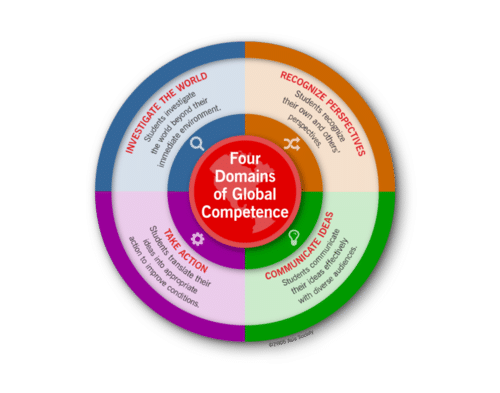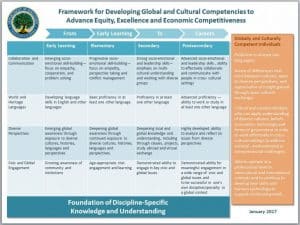Educating for Global Competence: 6 Reasons, 7 Competencies, 8 Strategies, 9 Innovations
CompetencyWorks Blog
 This post originally appeared at Getting Smart on September 5, 2017.
This post originally appeared at Getting Smart on September 5, 2017.
Everything is global–trade and economics, media and information. Young people are more likely than ever to interact with people from different cultures while at home and on the road. As we become more connected, more interdependent, how do we prepare young people for the world they will inherit? We see six reasons, seven competencies, eight strategies and nine innovations.
6 Reasons Global Competence Matters
The Asia Society Center for Global Education notes five reasons why global competence matters and we should be engaging young people now in learning experiences that focus on developing these skills, attitudes and dispositions. We added an additional benefit.
1. Global competence is the toolkit that a productive, involved citizenry uses to meet the problems and opportunities of the world. In the curriculum, global competence challenges students to investigate the world, consider a variety of perspectives, communicate ideas and take meaningful action. A globally focused curriculum engages students in their own learning and motivates them to strive for knowledge and understanding. And a curious, inspired student strives to learn more in school and beyond.
2. A new generation of students requires different skills from the generations that came before. The world is changing fast. Boundaries—literal as well as figurative— are shifting and even disappearing altogether. The culture that once lived halfway around the world now lives just down the block. The ability to thrive in this new and rapidly changing environment is grounded in a globally focused curriculum.
3. More than ever before, individual actions reach around the globe. Environmental concerns, economic shifts, global poverty, population growth, human rights and political conflict can seem intractable and overwhelming, yet they absolutely require thoughtful action. In a globally focused curriculum, students learn that the world needs them to act, and that they can make a difference.
4. Global competence integrates knowledge of the world and the skill of application with the disposition to think and behave productively. Global competence is not restricted to knowing about other cultures and other perspectives. In addition to knowledge of the world, a globally competent citizen exhibits habits like critical thinking, rational optimism, innovation, empathy and awareness of the influences of culture on individual behavior and world events.
5. Success in career and life will depend on global competence, because career and life will play out on the global stage. Already, government, business and cultural institutions are called to solve the world’s problems cooperatively. Engaging in these challenges requires high-order knowledge and thinking skill, as well as shared language and cultural understanding. In a globally focused curriculum, students prepare to approach problems from multiple perspectives and to thrive in a global future.
6. Working with and building relationships with people who have different backgrounds adds meaning, depth and joy to your life. Varied perspectives and worldviews enhance our own understandings and constructs (both mental and social).
In Education for Global Competence: Preparing our Youth to Engage the World, Asia Society expounds upon these reasons for preparing for global competence and details exactly what they feel the four skills of globally competent students are:

1. Investigate the world beyond their immediate environment: Framing significant problems and conducting well-crafted and age-appropriate research.
2. Recognize perspectives, others’ and their own: Articulating and explaining such perspectives thoughtfully and respectfully.
3. Communicate ideas effectively with diverse audiences: Bridging geographic, linguistic, ideological and cultural barriers.
4. Take action to improve conditions: Viewing themselves as players in the world and participating reflectively.
7 Global Competencies
Making your way in a complex world takes a broad range of knowledge, skills and practices. David Young from Participate outlines seven priority competencies:
1. Appreciation of culture. Students see their own cultures as strengths, seek to understand the cultures of others, are aware of similarities and differences among cultures and understand that behaviors and values are often tied to cultures.
2. Evaluation of information. Students regularly question easily accessible information to seek deeper understanding and thoughtfully evaluate materials and perspectives, rather than accepting things at face value.
3. Cross-cultural communication skills. Students effectively exchange ideas with peers and adults from different backgrounds — either virtually or in person — and have the skills to enter new communities and spaces.
4. Perspective taking skills. Students demonstrate curiosity and empathy and may show compassion for the perspectives of others.
5. Intelligent humility. Students understand that their knowledge is not finite and appreciate how much more there is to learn about the world. Students understand the grandiosity of the world and its complexities.
6. Divergent thinking. Students see alternative or original solutions to existing problems and can envision the world differently from how it currently exists.
7. Technological literacy. Students utilize and explore existing technologies to communicate and collaborate with others, and to learn and share new ideas and information. Students create new technologies or discover new uses for technologies that help them and others navigate their worlds
P21 has K-12 Indicators for Global Readiness that focus on the themes of Understanding, Investigating, Connecting and Integrating.
Another great framework is the ASCD Globally Competent Learning Continuum, originally developed at the University of North Carolina at Chapel Hill School of Education.
The U.S. Department of Education created the Framework for Developing Global and Cultural Competencies to Advance Equity, Excellence and Economic Competitiveness. They believe, “more than ever, our students need to be equipped with the critical thinking, communications, socio-emotional and language skills to work collaboratively with their counterparts in the United States and all over the world.”
8 Strategies That Promote Global Competence
1. Support world language fluency: Developing fluency in at at least one other language is valuable and an integral part of developing global competence. (See What’s Next in Language Learning and Dual Language Education for Equity & Economic Development.)
2. Take a big view. Incorporate a global view every day in every subject. Take a big view of history. Use resources like Big History Project to spur interdisciplinary studies.
The California Department of Education hosted a summit last year that resulted in comprehensive recommendations for integrating global experiences into the curriculum and culture of California schools.
3. Demonstrate intercultural competence. Intercultural competence, “the ability to develop targeted knowledge, skills and attitudes that lead to visible behavior and communication that are both effective and appropriate in intercultural interactions” (from Deardorff), is especially important as students increasingly in schools and in the world interact with multiple cultures at any one given time.
4. Diversity. Schools that serve diverse populations have a gift that can be used and explored to build global competence. More homogeneous schools can create pen pal connections and school partnerships to promote intercultural connections and unpack their own cultural backgrounds, beliefs and norms.
5. Support travel. Travel introduces students to other cultures and builds wayfinding (adaptive problem solving) skills. Global Citizen Year is one example of a provider that facilitates global place-based ed experiences for students. (Listen to Tony Klein at University Academy and Seth Andrew founder of Democracy Prep describe why travel is so important for youth from low resource communities)
6. Make room for projects. “PBL is the how for addressing global readiness,” said Andrew Miller, Buck Institute for Education faculty and Instructional Coach at Shanghai American School.
7. Global to Local. We see 32 important issues that students need to be investigating throughout their academic careers. They include ending hunger and poverty, clean water and sanitation, taking climate action, building smart cities and exploring space. They are global issue but nearly all can be explored locally. What does poverty look like in my town? How can I reduce hunger where I live? Does my solution have merit for impoverished communities around the world?
Let students lead: How local investigations drive democratic and global learning explains how local investigations provide students connections to bigger issues and drive community engagement and engaging real-world projects.
8. City as classroom. “Make the city the text,” says Larry Rosenstock, founder of High Tech High in San Diego. We call it place-based education–immersive learning experience that place students in local heritage, cultures, landscapes, opportunities and experiences.
9 Innovations Transforming Global Education
Advances in EdTech tools and learning models is making it easier for everyone to embrace global learning and there is overall improvement in access to educational opportunities around the world (whether they are focused on global issues or not).
1. Electricity: Let’s start with the basics–about a billion people still lack power, so reliable sustainable sources of power especially for remote regions is an important area of development.
2. Ubiquitous wifi: Most urban areas have access to wifi and it’s getting better in rural areas worldwide.
3. Inexpensive devices: Smart phones and cheap access devices have extended access to digital learning in the U.S. and worldwide.
4. Communication tools. Email, text, video conferencing make it easier to connect globally. Apps like ePals, Empatico and PenPal Schools are devoted to connecting classrooms. Facebook, WeChat and Edmodo facilitate groups and individual connections.
5. Literacy and numeracy tools: Adaptive learning tools that support literacy, numeracy and computational thinking development
6. Online learning: It’s getting easier to learn world languages online with rich curriculum and online tutoring.
7. Translation: Machine learning is rapidly improving online translation tools.
8. AR/VR: New virtual reality content like Google Expeditions makes it easier to visit the world. Augmented reality field trips will expand the value of local and global field trips.
9. School networks: Low cost private school networks (like Bridge International Academies) are extending access in the poorest neighborhoods in the world. U.S. schools networks (including Asia Society) are extending global education.
Where ever you start, keep the overarching reason you are preparing students for global competence in mind–they ALL deserve a world class education, one that invites them to grow their own global understandings, connections and abilities.
See also:
- Developing Self-Directed Learners
- Getting to Know Students’ Business: A Conversation at Lincoln-West’s Schools of Global Studies and Science & Health
- Preparing Students for Life….Not Just College and Careers
Tom Vander Ark is founder and CEO of Getting Smart. He is also a partner in Learn Capital and a director of iNACOL, Digital Learning Institute, Imagination Foundation, Charter Board Partners, Strive for College, and Bloomboard.
Emily Liebtag is a Director at Getting Smart. Follow her on Twitter: @EmilyLiebtag.
